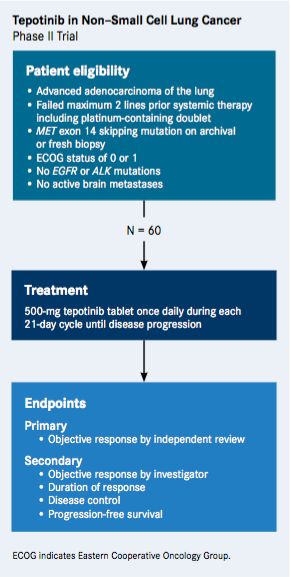Tepotinib Takes Aim at Novel MET Mutation in Lung Cancer Trial
Tepotinib, an investigational small molecule that targets a recently identified aberration in the MET gene, is moving forward rapidly in clinical development for patients with non–small cell lung cancer who harbor the mutation, raising hopes that a more specific attack on the signaling pathway will lead to a new therapy for a significant subgroup of individuals with the disease.
Paul K. Paik, MD

Paul K. Paik, MD
Tepotinib (MSC2156119J), an investigational small molecule that targets a recently identified aberration in the MET gene, is moving forward rapidly in clinical development for patients with non—small cell lung cancer (NSCLC) who harbor the mutation, raising hopes that a more specific attack on the signaling pathway will lead to a new therapy for a significant subgroup of individuals with the disease.
The drug is being evaluated in a single-arm phase II trial for patients with stage IIIB/IV lung adenocarcinomas who have progressed after prior chemotherapy and whose tumors test positive for the MET exon 14 skipping mutation (NCT02864992). The study, which was launched in July, aims to enroll 60 patients.
An estimated 3% to 4% of patients with NSCLC are believed to harbor the skipping mutation, about the same frequency as the incidence of ALK rearrangements, said Paul K. Paik, MD, a medical oncologist at Memorial Sloan Kettering Cancer Center who is the global principal investigator on the trial. He led one of the first research teams to identify the mutation as a potential therapeutic target in lung cancer last year.1
“It’s an unmet need for those patients, which translates worldwide to quite a large number of people,” considering the prevalence of lung cancer, said Paik in an interview with OncLive. An estimated 1.8 million individuals are diagnosed globally with lung cancer each year.2
Paik noted that MET signaling has been the subject of active research in lung cancer for years in patients with a high expression of the MET protein or amplification of the gene, or for individuals with EGFR-mutant disease with a higher MET expression, possibly due to a resistance mechanism.

To target MET, investigators have tried 2 strategies: monoclonal antibodies directed against the MET receptor or its ligand and tyrosine kinase inhibitors.1 However, results have been mixed. In addition, there are 2 multikinase inhibitors approved by the FDA, crizotinib (Xalkori) and cabozantinib (Cometriq/Cabometyx), which among other receptors also target MET.
Now, the focus has shifted to the exon 14 skipping mutation as an alteration that appears predictive for response to MET inhibitors, Paik said. Notably, investigators believe these alterations are mutually exclusive with mutations in EGFR and ALK3 that would be targeted by less speci c agents.
Last year, Paik and colleagues described 4 case studies in which patients ranging in age from 65 to 90 years with advanced lung cancer with exon 14 skipping mutations received either crizotinib or cabozantinib. One patient with a 5-cm liver metastasis experienced a complete response after 4 weeks of daily cabozantinib therapy, while 2 others achieved partial responses with crizotinib.1
Paik said this study helped lay the groundwork for tepotinib, which specifically targets MET. He said the agent inhibits MET more potently than crizotinib and, because of its specificity, appears to have fewer adverse effects. The appropriate dosing was established in phase I testing.
Patients treated with the drug have experienced fewer of the adverse events typical of the MET-targeting class of drugs, such as gastrointestinal side effects, liver function laboratory abnormalities, and peripheral edema, according to Paik. “In terms of tolerability in the phase I experience it’s a very well-tolerated drug,” he said.
Specifically, the mutation is as its name implies: exon 14 is spliced out—or skipped—during the processing of RNA.1 “There is a normal mechanism to delete out portions of the RNA and the protein. These alterations end up deleting out in a deleterious way this one section of the RNA and subsequently the protein,” said Paik.
“That section is very important,” he continued. “It has the key amino acid that allows the cell to target that receptor for degradation so when that part is deleted out, the receptor is stabilized, the turnover rate is decreased, and we think that is why there is increased dependence on that protein.”
At present, the exon 14 alteration is detected through DNA sequencing that includes noncoding regions (introns), which are starting to be incorporated into testing panels, said Paik. He said investigators are conducting the testing on tissue samples during the trial but will be studying participants’ blood draws to see whether similar results can be obtained from circulating DNA.
Although Paik’s study zeroes in on the exon 14 alteration, tepotinib also is being evaluated in a more broadly MET-positive population in a phase I/II trial (NCT0198255). In that study, patients with locally advanced or metastatic NSCLC are being randomized to receive either tepotinib plus gefitinib or platinum plus pemetrexed.
Tepotinib is being developed by Merck KGaA, Darmstadt, Germany, and operates in the United States as EMD Serono, Inc.
References
- Paik PK, Drilon A, Fan PD, et al. Response to MET inhibitors in patients with stage IV lung adenocarcinoma harboring MET mutations causing exon 14 skipping. Cancer Discov. 2015;5(8):842-849. doi:10.1158/2159-8290.CD-14-1467.
- International Agency for Research on Cancer. GLOBOCAN 2012: lung cancer estimated incidence, mortality and prevalence worldwide in 2012. http://globocan.iarc.fr/Pages/fact_sheets_cancer.aspx. Published January 12, 2016. Accessed December 1, 2016.
- Paik PK, Stammberger U, Bruns R. A phase II trial investigating the highly selective c-Met inhibitor tepotinib in stage IIIB/IV lung adenocarcinoma with MET exon 14 alterations after failure of at least one prior therapy. Ann Oncol. 2016;27(suppl 6; abstr 1292TiP). doi:10.1093/annonc/mdw383.92.